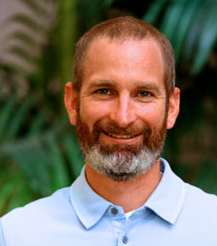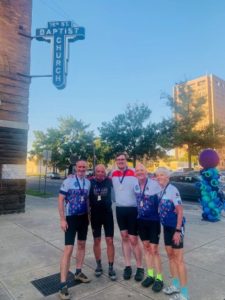
In his “Letter from a Birmingham Jail,” Martin Luther King Jr. lamented the white moderate clergy who were more committed to order than to justice. There’s no doubt these lovers of the status quo would have considered themselves not-racist. After all, they were pastors – people called to love God and neighbor. However, being not-racist during the Civil Rights Movement, in the midst of murder, lynching, theft and almost every other degradation known to humanity, wasn’t enough.
If being not-racist wasn’t enough then, is it enough now?
That question was on my mind as I joined 20 cyclists on Civil Rides, a 150-mile cycling pilgrimage from Montgomery to Birmingham that traveled through some of the most hallowed and blood-soaked ground of the Civil Rights Movement.

Civil Rides bicyclists outside 16th Street Baptist Church in Birmingham.
Riders teared up at the Equal Justice Initiative’s lynching memorial in Montgomery, Alabama. The memorial commemorates more than 4,000 documented victims of racial terror lynchings of African Americans, concentrated mostly in 12 Southern states. In Marion, we remembered the events at Zion United Methodist Church where Jimmie Lee Jackson was looking for his grandfather when he was shot and killed. He didn’t go looking for trouble; it found him in the form of two racist police officers and a system that said his life wasn’t valuable.
Jackson’s death sparked the march to Selma. We rode across the Edmund Pettus Bridge, recalling that day when Alabama state troopers mercilessly beat King and Congressman John Lewis, among many others, as they attempted to walk in peaceful, nonviolent resistance. The marchers were protesting the killing of Jackson and a system that denied African American citizens their constitutional right to vote.
We ended our ride at the 16th Street Baptist Church in Birmingham, pausing to remember the four little girls, dressed in their Sunday best, who were murdered by white supremacist members of a local KKK chapter who planted a bomb beneath the church steps. The girls’ stories were the story of living while black in America and especially in the South.
“Living while black wasn’t just dangerous 50-60 years ago in the places we cycled through; living while black is dangerous now.”
As I feared for my life while cycling beside a busy two-lane highway with a continuous line of trucks and cars flying by, I contemplated the dangers faced by African Americans during the Civil Rights Movement. But that kind of danger is a thing of the past, right? Surely, it’s a sad memory of days gone by. After all, most people today would say they are not-racist.
But is that enough? The beaten, bloodied and marginalized lives of African Americans scream, “No!”
You could have asked Botham Jean, killed by a police officer in his own apartment. Or asked Atatiana Jefferson, shot to death by a police officer playing video games in her bedroom with her nephew. Or you can ask African American mothers who are struggling with the reality of high infant mortality rates. Or ask African American men whose average life expectancy is four years less than white men. These disparities exist across virtually every area of life, from economics to education to health.
Living while black wasn’t just dangerous 50-60 years ago in the places we cycled through; living while black is dangerous now. Today’s events of racial injustice are a continuation of the past. The racist systems of the past didn’t die; they just morphed into something different.
As I pedaled furiously with the cars and trucks zipping by me, I was reminded that as a white man I often have to search out danger to find it. It’s not an everyday reality. Most everything in life is tailored towards me, my happiness and my well-being, including the very ability to participate in Civil Rides. As a white person in a predominately white environment, I am not routinely viewed with suspicion and distrust. I have greater access to networks and resources to help me in life. I can call the police without worry that I’ll be treated unfairly – or worse.
Maybe more subtle but even more important is that even when I find myself in danger, I have options. I can get off the bike, wave a support vehicle down, hop in the truck and find myself safe again – another example of white privilege.
I completed the Civil Ride with a deeper awareness that those of us with white privilege need to own it, move from not-racist to anti-racist. We must listen to, and work alongside, our African American brothers and sisters to ensure that although they may have dangers like riding a bike along a busy highway, their lives are never in danger due simply to the color of their skin.
